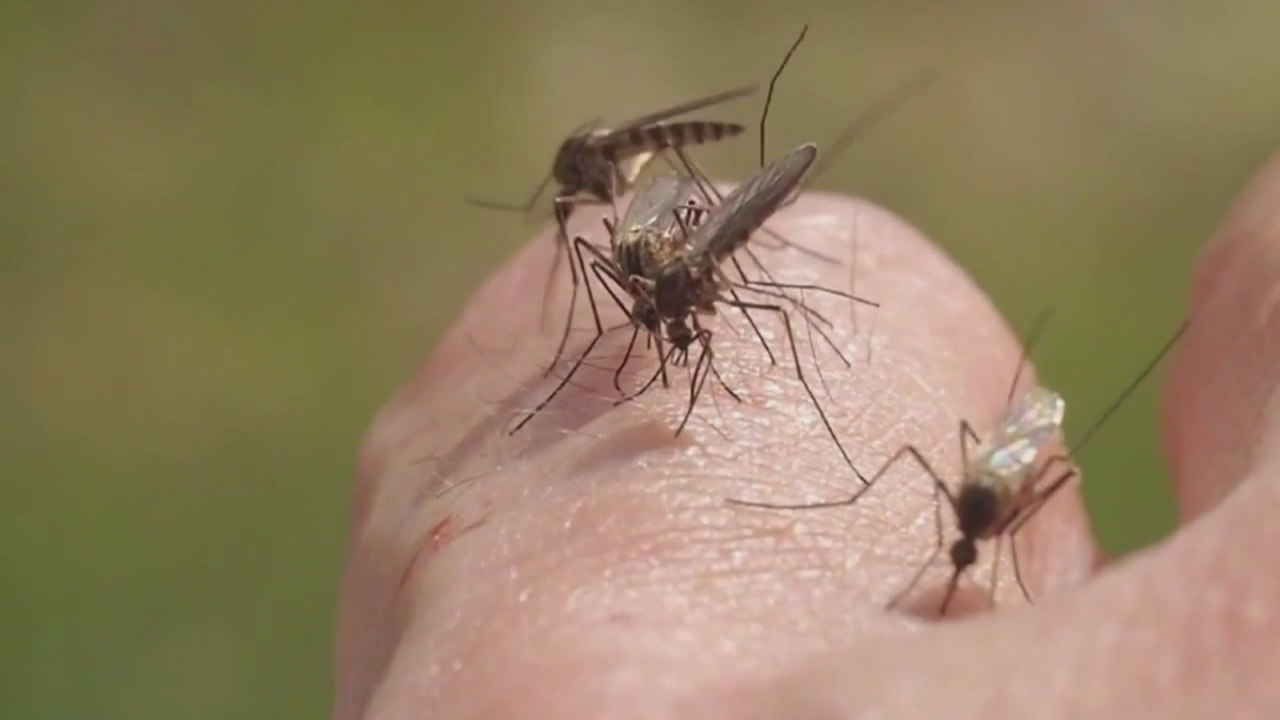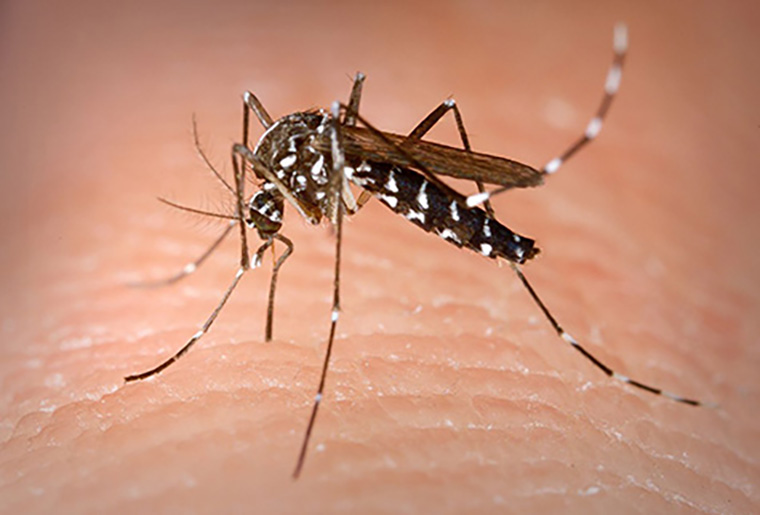Mosquito of the Month: Aedes Aegypti – The Yellow Fever Mosquito
“Celebrity status” isn’t generally something bestowed upon an insect. And yet one mosquito, Aedes aegypti, has been a part of the Zika headlines almost daily for much of the last year, garnering nearly as much attention from the press as the presidential candidates during this election year.
No other mosquito species has had such a dramatic impact on human history. Also known as the Yellow Fever Mosquito, Aedes aegypti was the first mosquito implicated as a vector of human disease. Experiments in the 1880’s by Cuban physician, Carlos Finlay, demonstrated that when one of these mosquitoes took a blood meal from a patient with Yellow Fever, it could transmit the disease to a healthy person just a couple days later during a subsequent bite. Initially, few people – including members of the scientific community – took the idea seriously, finding it hard to believe that such a small insect could kill a full grown person. It took a couple of decades and many additional experiments to finally prove Finlay’s theory.
 Today, many mosquito species have demonstrated the ability to be competent vectors of a variety of mosquito-borne diseases affecting not only humans but also many other animals. Aedes aegypti not only carries Yellow Fever, but is also a vector of West Nile virus, chikungunya, dengue, and more recently making the news as the primary vector of the Zika virus. While a vaccine exists now to protect us from Yellow Fever, vaccines for the other diseases are still under development and keeping a close eye on the Aedes aegypti species remains a top priority in many Integrated Mosquito Management (IMM) programs.
Today, many mosquito species have demonstrated the ability to be competent vectors of a variety of mosquito-borne diseases affecting not only humans but also many other animals. Aedes aegypti not only carries Yellow Fever, but is also a vector of West Nile virus, chikungunya, dengue, and more recently making the news as the primary vector of the Zika virus. While a vaccine exists now to protect us from Yellow Fever, vaccines for the other diseases are still under development and keeping a close eye on the Aedes aegypti species remains a top priority in many Integrated Mosquito Management (IMM) programs.
The reports in the news focus on this mosquito’s role as a disease vector, labeling it as an evil species worthy of extinction. In fact, current research is developing technologies that may allow us to eradicate this species completely in the not-too-distant future, an ethical dilemma during a time when millions of dollars are spent annually to protect other species from extinction. As an entomologist, I find it hard not to admire the adaptability of this mosquito that only a few hundred years ago existed unnoticed by most humans in the dense tropical forests of Africa. Centuries of shipping trade, especially the trans-Atlantic transport of African slaves in the early-16th through mid-19th centuries, have spread Aedes aegypti (and diseases that it carries) around the world, establishing permanent populations in warmer climates.
 Like the closely related Asian Tiger Mosquito (Aedes albopictus), the Yellow Fever mosquito is quite beautiful on a microscopic scale. Jet black scales adorn the body and legs, marked by bright silvery-white scales on the sides of their thorax and abdomen, and ringed with white bands on each leg segment. A distinctive pattern of white scales form a “lyre-shaped” pattern on the top of the thorax. [What is a “lyre” you ask? It is that miniature harp-like string instrument that was a favorite of ancient Greek musicians.]. This is a stunning beauty as mosquitoes go.
Like the closely related Asian Tiger Mosquito (Aedes albopictus), the Yellow Fever mosquito is quite beautiful on a microscopic scale. Jet black scales adorn the body and legs, marked by bright silvery-white scales on the sides of their thorax and abdomen, and ringed with white bands on each leg segment. A distinctive pattern of white scales form a “lyre-shaped” pattern on the top of the thorax. [What is a “lyre” you ask? It is that miniature harp-like string instrument that was a favorite of ancient Greek musicians.]. This is a stunning beauty as mosquitoes go.
Several features of this mosquito’s natural history have allowed it to adapt to life around humans successfully. In their native African forests, rain-filed containers, especially those found in tree-hollows, served as home to the larval stage of the mosquito. Females lay eggs just above the water surface, such that when the container fills, the eggs are flooded and hatch. The eggs can remain dry for years without hatching, waiting for rain water to flood them. Human habitations are surrounded by similar small watery containers, including rain gutters, flower pots, bird baths, and even children’s toys that could serve as larval habitats for the Yellow Fever mosquito.
Ironically, many cemeteries where victims of Yellow Fever are buried have flower vases attached to the tomb stones, holding enough water to serve as larval habitat for more Yellow Fever mosquitoes. One of the most effective ways to control this species is to simply eliminate water containers around the home where the larvae could live. These mosquitoes are also daytime fliers, a challenge for control programs that only target the adults since daytime pesticide fogging can increase the likelihood of negative impacts on non-target insects.
Will the Yellow Fever Mosquito be allowed to continue impacting human history through the spread of disease? We have the capability to reduce their populations and thereby reduce the incidence of diseases that they vector. Perhaps we are within our right to eradicate it from most of the planet, especially since humans are responsible for expanding this mosquito’s range around the world. However, perhaps extinction is more than it deserves, and relict populations of this beautiful insect can be allowed to persist in the dense uninhabited forests of its native Africa.
Contact Us
Contact the vector professionals at 800.413.4445 for all your integrated tick & mosquito control needs.
 Since 1992, Vector Disease Control International (VDCI) has taken pride in providing municipalities, mosquito abatement districts, industrial sites, planned communities, homeowners associations, and golf courses with the tools they need to run effective mosquito control programs. We are determined to protect the public health of the communities in which we operate. Our mosquito control professionals have over 100 years of combined experience in the field of public health, specifically vector disease control. We strive to provide the most effective and scientifically sound mosquito surveillance and control programs possible based on an Integrated Mosquito Management approach recommended by the American Mosquito Control Association (AMCA) and Centers for Disease Control and Prevention (CDC). VDCI is the only company in the country that can manage all aspects of an integrated mosquito management program, from surveillance to disease testing to aerial application in emergency situations.
Since 1992, Vector Disease Control International (VDCI) has taken pride in providing municipalities, mosquito abatement districts, industrial sites, planned communities, homeowners associations, and golf courses with the tools they need to run effective mosquito control programs. We are determined to protect the public health of the communities in which we operate. Our mosquito control professionals have over 100 years of combined experience in the field of public health, specifically vector disease control. We strive to provide the most effective and scientifically sound mosquito surveillance and control programs possible based on an Integrated Mosquito Management approach recommended by the American Mosquito Control Association (AMCA) and Centers for Disease Control and Prevention (CDC). VDCI is the only company in the country that can manage all aspects of an integrated mosquito management program, from surveillance to disease testing to aerial application in emergency situations.

